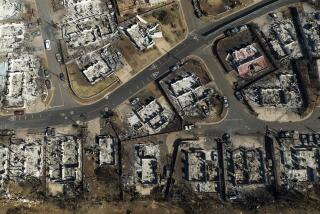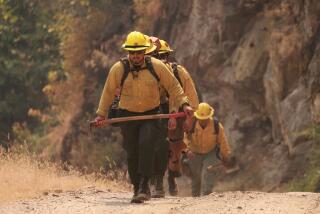Youth Not a Factor in Deaths
WINTHROP, Wash. — The investigation into the deaths of four young firefighters has found no evidence that youth or inexperience were factors. Instead, there was simply no time for them to escape an inferno “beyond your imagination,” a U.S. Forest Service official said Monday.
Fourteen firefighters were trapped last week when the Thirty Mile Fire exploded from 25 to 2,500 acres in less than three hours. The four who died July 10 were among six who set up emergency shelters in a rock field above a road along the Chewuch River. Two of them survived, though one remained hospitalized Monday with severe burns to his hands.
The others, joined by two civilians, deployed their shelters in the road.
Rock fields and roads are both considered good shelter areas for firefighters unable to reach a safe area--and this fire blew up so fast there was no time to get out, said Jim Furnish, a deputy Forest Service chief leading the investigation into the deaths.
Weather was not a factor in the fire’s quick and deadly change, he said. Instead, months of drought after two dry years created a wealth of dry fuel that “enabled the fire to create its own strong winds,” Furnish told a news conference.
Asked what it was like along the riverbank as the fire roared through, he said: “It is beyond your imagination.”
The four who died--Tom L. Craven, 30; Devin A. Weaver, 21; Jessica L. Johnson, 19; and Karen L. FitzPatrick, 18--were joined in the rocks by Jason Emhoff and firefighter Tom Taylor, Furnish said.
Investigators hope to talk to Emhoff later to determine what he might have done differently from the others. Emhoff had surgery Monday at Harborview Medical Center in Seattle. Doctors determined he will not face amputation of his hands.
The investigation continues, Furnish said, adding that the Forest Service wants to “understand the lessons to be learned from this.”
On Monday, crews moved to the northwestern flank of the Thirty Mile Fire on Monday to limit its spread into the Pasayten Wilderness in north-central Washington.
A trail has been built around 35% of the 9,500-acre blaze on the east slopes of the Cascade Range, said Jim Heuring, spokesman for the state Department of Natural Resources.
Cooling temperatures improved conditions and boosted morale for the fire crews, though the cold front also brought a threat of wind gusts.
More to Read
Sign up for Essential California
The most important California stories and recommendations in your inbox every morning.
You may occasionally receive promotional content from the Los Angeles Times.










